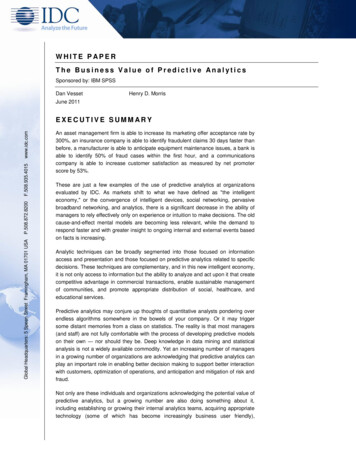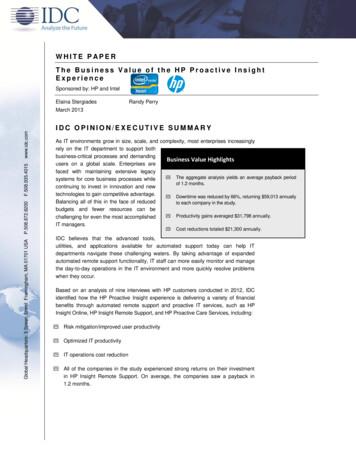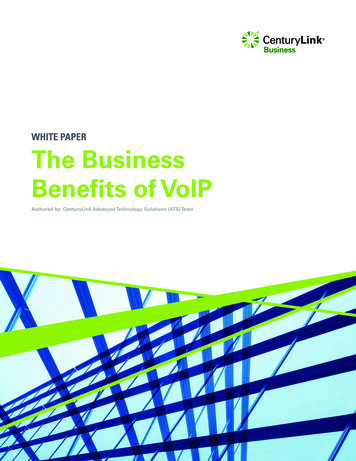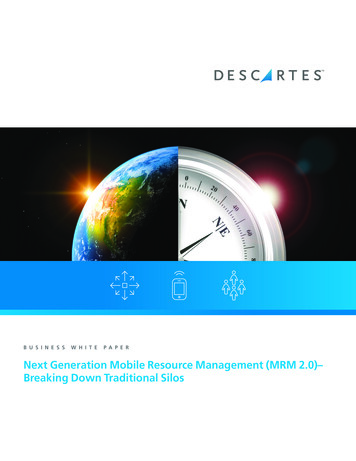
Transcription
WHITE P APERThe Business Value of Predictive AnalyticsSponsored by: IBM SPSSDan VessetHenry D. MorrisJune 2011Global Headquarters: 5 Speen Street Framingham, MA 01701 E SUMMARYAn asset management firm is able to increase its marketing offer acceptance rate by300%, an insurance company is able to identify fraudulent claims 30 days faster thanbefore, a manufacturer is able to anticipate equipment maintenance issues, a bank isable to identify 50% of fraud cases within the first hour, and a communicationscompany is able to increase customer satisfaction as measured by net promoterscore by 53%.These are just a few examples of the use of predictive analytics at organizationsevaluated by IDC. As markets shift to what we have defined as "the intelligenteconomy," or the convergence of intelligent devices, social networking, pervasivebroadband networking, and analytics, there is a significant decrease in the ability ofmanagers to rely effectively only on experience or intuition to make decisions. The oldcause-and-effect mental models are becoming less relevant, while the demand torespond faster and with greater insight to ongoing internal and external events basedon facts is increasing.Analytic techniques can be broadly segmented into those focused on informationaccess and presentation and those focused on predictive analytics related to specificdecisions. These techniques are complementary, and in this new intelligent economy,it is not only access to information but the ability to analyze and act upon it that createcompetitive advantage in commercial transactions, enable sustainable managementof communities, and promote appropriate distribution of social, healthcare, andeducational services.Predictive analytics may conjure up thoughts of quantitative analysts pondering overendless algorithms somewhere in the bowels of your company. Or it may triggersome distant memories from a class on statistics. The reality is that most managers(and staff) are not fully comfortable with the process of developing predictive modelson their own — nor should they be. Deep knowledge in data mining and statisticalanalysis is not a widely available commodity. Yet an increasing number of managersin a growing number of organizations are acknowledging that predictive analytics canplay an important role in enabling better decision making to support better interactionwith customers, optimization of operations, and anticipation and mitigation of risk andfraud.Not only are these individuals and organizations acknowledging the potential value ofpredictive analytics, but a growing number are also doing something about it,including establishing or growing their internal analytics teams, acquiring appropriatetechnology (some of which has become increasingly business user friendly),
reassessing information collection and integration processes, and evaluating needsfor outsourcing some predictive analytics processes.These investments have been shown to produce outsized returns in the form ofbusiness process enhancements across the organization. IDC research shows that: The return on investment (ROI) of business analytics solutions that incorporatepredictive analytics is about 250%, significantly higher than the 89% ROI ofprojects focused only on information access and internal productivity gains. Benefits of predictive analytics projects are sustained over long periods of time,and those that rely more on analytics tend to be more competitive. Predictive analytics projects result in many intangible or difficult to quantifybenefits that give further impetus to investment in these solutions. Investment in predictive analytics continues at a healthy pace, even in tougheconomic times. For example, over the past 10 years, the compound annualgrowth rate (CAGR) of the IDC-tracked 1.6 billion worldwide advanced analyticssoftware market has been 7%, compared with a 3% CAGR for the overall ITmarket during the same period.SITUATION OVERVIEWEight years ago, IDC conducted a market research study involving an in-depthevaluation of the ROI of business analytics solutions at 43 organizations in NorthAmerica and Western Europe.Since that time, IDC has continued to evaluate the benefits of business analyticsoverall and predictive analytics in particular. Our latest research, conducted in 2011,extended the original research with additional in-depth interviews and a survey of 200United States–based organizations.Predictive and Non-Predictive Analytics:Different But ComplementaryA variety of technologies form the basis for business analytics solutions. But not allanalytics are predictive. At their core, predictive analytics are all about identifying andimproving the probability or likelihood of an event, action, or behavior. The software tosupport and automate predictive analytics includes tools for statistical analysis, anddata and text mining. We define the two types of projects as follows:At their core,predictive analyticsare all aboutidentifying andimproving theprobability orlikelihood of an event,action, or behavior. Predictive business analytics projects utilize tools that IDC classifies asadvanced analytics (i.e., tools that incorporate technologies that applymathematically oriented techniques such as neural networks, rule induction, andclustering to discover relationships in the data and make predictions).Alternatively, predictive projects implement packaged analytic applications thatincorporate predictive technologies, such as a fraud detection application.2#229061 2011 IDC
Non-predictive business analytics projects utilize business intelligence tools thatIDC classifies as end-user query, reporting, and analysis. Alternatively, nonpredictive projects implemented packaged analytic applications that incorporatedthese technologies.In our analysis, projects that incorporated both predictive and non-predictivetechnologies were classified as "predictive." In these cases, technologies such asbusiness intelligence for query, reporting, and analysis support the overall predictiveanalytics efforts and are therefore frequently used in conjunction with predictiveanalytics technologies.The ROI of Predictive AnalyticsEight years is a very long time in the IT industry. Many changes have occurred duringthis time to system performance and software capabilities as well as to generalawareness of the market of the value of business analytics in general and predictiveanalytics in particular. The following points highlight some of the key changes in IDCresearch results over this time period as well as other overall highlights of benefitsfrom predictive analytics projects: Based on IDC research, the median ROI of predictive analytics projects is closeto three times higher than that of non-predictive projects.The median ROI of predictive analytics projects is 250%, which represents anincrease from the 145% average ROI from IDC's 2003 study. Other keydifferences over the past eight years in projects involving predictive analyticswere: The volume and variety of data being analyzed. For example, anincreasing number of organizations are improving their predictive models byevaluating and training them on combined sets of structured and semistructured data with unstructured content. The higher priority and imperative of predictive analytics amongorganizations' overall initiatives. Predictive analytics has certainly becomea topic of many more conversations and gained a new respect among "nonquants."The median ROI ofpredictive analyticsprojects is 250%. Many of the benefits of predictive analytics projects are ancillary to the directlyquantifiable benefits that can be captured through a formal ROI calculation. Major benefits of business analytics projects that employed predictive analyticscenter on business process enhancement, especially improving the quality ofoperational decisions. This contrasts with the primary benefit of non-predictiveanalytics projects, which focus on productivity improvement. Yet, in most cases,predictive and non-predictive analytics are deployed together as part of a broaderbusiness analytics solution.In measuring ROI, IDC identified and measured two types of benefits — processenhancement and productivity improvement. In our research, we defined business 2011 IDC#2290613
process enhancement as the ability to improve or change how the organizationoperates (e.g., created new business processes and/or introduced new products orservices, better customer segmentation, and/or better accuracy in detecting fraud). Inthis case, the results of deploying analytics resulted in driving more revenue (e.g.,attracting more sales in a marketing campaign) or recovering costs (e.g., identifyingfraud and acting on this to reduce payments that otherwise would have been made).Projects employing predictive analytics typically showed more of these benefits.Productivity gain was defined as the ability to achieve efficiency savings due to thereduced amount of time, effort, or people required for particular tasks (e.g., fasterdata collection, faster report development). In this case, the primary benefit was theability to save labor costs. For example, a project using improved process forreporting (possibly with more automated data integration) results in less labor (e.g.,fewer people required for the financial closing process that is reporting oriented). Wecan measure the difference in person-hours for completing the process, before theproject was implemented and afterward. However, productivity gains often result in a"soft" benefit — meaning that unless you have decreased your personnel, thesepeople are still on the payroll doing other tasks. So the firm may not have reduced itscosts when all is considered.Predictive Analytics ProjectsPredictive analytics have applicability to a wide range of business processes. In oneexample, an asset management firm used predictive analytics to improve marketingefforts. The company wanted to change from a mass marketing approach whereevery prospect received the same offer to an approach that enabled personalization.The company used predictive analytics to predict the likelihood of a prospectivecustomer accepting an offer. After deployment of predictive analytics, the acceptancerate increased by 300%, translating into several hundred million additional dollarsunder management, of which this firm receives a management fee. As one of the vicepresidents interviewed by IDC said, "We experienced a shift from product marketingto customer marketing."Predictive analyticshave applicability to awide range ofbusiness processes.The additional revenue created what could be viewed as an annuity stream of netnew revenue. In addition, one of the benefits was a substantial decrease in thenumber of direct mail pieces sent by the company. IDC estimates that the companyachieved an ROI of 374% on this particular project, which included an initialinvestment of about 875,000 in services, staff, and technology. By reassigningexisting staff, the company did not create a new IT or data management team tosupport the predictive analytics solutions. Nor did it hire new market staff. Instead itrelied on an outside consulting firm to execute on the newly available insight.Although the company's management estimates that 98% of benefits were businessprocess enhancement rather than IT cost savings or productivity gains, the companydid complement predictive analytics with a rules engine and query and reportingsoftware.In another case, an auto insurance company used the predictive analytics solution asa basis to reengineer its claims department. The ability to identify and score initialclaims using predictive analytics software allowed the company to shift first notice ofloss processes from the call center to first line claim adjusters. As a result, 22% of4#229061 2011 IDC
initial claims were taken out of field operations — a costly, labor-intensive processrequiring more experienced adjusters to be sent out to evaluate property damage.The company did create a new analytics team that added labor costs, but thesequantitative analysts are now supporting the rest of the adjusters.The company was also able to improve its fraud detection and prevention practices.The predictive analytics solution has been utilized to continually build more robustrules for fraud detection, which has resulted in a drop in false positives for fraudinstances and better leads for fraud investigators. As a result, it now takes 24 hours to10 days (depending on the case) rather than the previous average of 40 days tomove a claim to the fraud investigation team. The ability to recognize fraud quickerhas improved margins, and the company believes that in some cases it has alsodeterred fraud.There were several other benefits that were either impossible to quantify or had notyet produced enough traceable information to be included in a formal ROI calculation.Nevertheless these benefits provide or are expected to provide the company withvaluable returns on its investment: The internal reorganization resulted in more specialized work groups. Forexample, the company set up a group of adjusters that focus on organized fraudby criminal groups, which takes longer to delve into. Deploying predictiveanalytics has had the added benefit of creating new career paths for existing(and new) employees, which in turn improved employee satisfaction. This was animportant objective for the company; as a senior VP of the company said, "Onthe one hand, these new solutions provided us with more automation. On theother hand, people are now dealing with more exceptions — a higher valueadded and more satisfying work."Deploying predictiveanalytics has had theadded benefit ofcreating new careerpaths for existing(and new) employees,which in turnimproved employeesatisfaction. Data into the claims system now comes from an expanded number of internaland external sources. For example, the company uses externally sourcedautomobile crash data to evaluate the probability of a specific type of damage.Using this new capability, analysts can calculate the probability of supplementaryor hidden damage. If this probability is high and fraud probability is low, thecompany does not send an adjuster out to review the claim, which providessavings from the new analytics-enabled business process. Predictive analytics have been extended into a net-new area of focus on medicalfraud, which has helped in identifying particular clinics and providers that mayhave patterns that represent fraud. These efforts have combined to decreaselitigation and external attorney costs by about 2 million a year.IDC estimates the original focus on fraud detection and prevention and claimsprocessing has resulted in an approximate 400% ROI. However, since then thecompany has taken further steps to also focus on customer service, customerretention, and sales. For example, there is currently focus on improving the netpromoter scores by assessing the likelihood of a customer to recommend theinsurance company to a friend or family member. 2011 IDC#2290615
This customer case is representative of another phenomenon that identifies mostcompetitive or leading organizations and their use of predictive analytics. That is thecross-departmental learning and incremental expansion of the use of predictiveanalytics throughout the organization. For example, applying predictive analytics tofraud detection and prevention can also inform marketing processes — a new serviceshould probably not be marketed to someone who has been identified as beinginvolved in fraudulent activity.In many cases, analysts working on predictive analytics in silos are in fact addressingvery similar issues such as scoring a customer based on risk factors and likelihood topurchase. Best practices call for analysts to share their analytic techniques as well asresults of the analysis to leverage such expertise across the organization.This does not mean that an enterprisewide predictive analytics initiative needs to bedeployed at once. Another best practice is to focus on incremental project execution,which enables showing quick returns from relatively small investments or cuttinglosses quickly when results are not favorable. However, each incremental projectshould build upon and learn from previous projects under a broader businessanalytics strategy.Best practices callfor analysts to sharetheir analytictechniques as well asresults of the analysisto leverage suchexpertise across theorganization.The two examples described represent a range of business processes (e.g., frauddetection, marketing, sales, customer service, and operational processes) that canbenefit from predictive analytics. These are not atypical cases. In fact, in the surveyIDC conducted of 200 organizations that were utilizing predictive analytics, we founda broad range of business processes where predictive analytics had made a positiveimpact. (For more information on the survey methodology, see the Appendix sectionof this paper.)Typically, predictive analytics are referenced in the context of business issues suchas fraud detection, customer churn prevention, and audience target marketing.However, the reality is that predictive analytics are being applied across all majorbusiness processes. However, the frequency of projects differs (as shown in Figure1), and given limited resources, focus should be placed on key processes that havethe potential to produce the highest impact. These are usually found within the coreoperational process of your organization, depending on the industry in which youwork. In insurance, that could be claims processing; in retail, it could be pricingoptimization; in banking, it could be fraud detection; and in telecommunications, itcould be customer churn prevention.Figure 1 depicts the business processes as well as the type of primary benefit derivedfrom the application of predictive analytics as reported by the survey participants. Foreach of these processes, business process enhancements trumped productivityimprovements as the primary change that resulted from the use of predictiveanalytics. The results ranged from the sales process, where 75% of surveyparticipants described the primary change resulting from the use of predictiveanalytics as business process enhancements, to the finance process, where thesame result was 51%. Although these results show the disparity in types of benefits,they also highlight the fact that in most cases there are both business processenhancements and productivity gains.6#229061 2011 IDC
FIGURE 1Application and Benefit Type of Predictive Analytics by Business ProcessQ.For each of the business process areas below, how would you describe the primary changethat resulted from the use of predictive analytics technologies and 20%20%10%10%0%0%Business process enhancementProductivity improvementTotaln 200Note: Data excludes "other" and "none of the above" responses.Source: IDC's Predictive Analytics Survey, March 2011Scope of BenefitsPopular descriptions of predictive analytics often depict this activity in terms ofuncovering an invaluable nugget of information — the needle in the haystack. Thereality is that while there are special projects where analysts are tasked with uncoveringinformation for a rare question, in 61% of the cases surveyed by IDC, organizationsderive ongoing benefits from predictive analytics. Furthermore, the largest group ofrespondents (39%) indicated that these are large, ongoing benefits (see Figure 2).From our interviews, we found many cases that resulted in substantial profitabilityimprovements from the ongoing application of predictive analytics. One of the VPlevel interviewees summarized his view as follows: "With predictive analytics, if you'reeven a little more right, the return is almost infinite." 2011 IDC#229061"With predictiveanalytics, if you'reeven a little m
analytics are predictive. At their core, predictive analytics are all about identifying and improving the probability or likelihood of an event, action, or behavior. The software to support and automate predictive analytics includes tools for statistical analysis, and data and text











